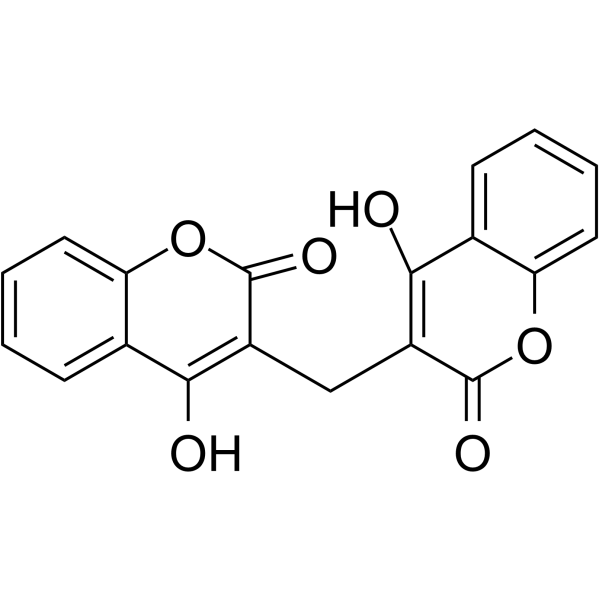天然产物 天然产物苯丙素类 Phenylpropanoids
Dicoumarol (Synonyms: 双香豆素; Dicumarol) 纯度: 99.59%
Dicoumarol 是 NAD(P)H: 醌氧化还原酶 1 (NQO1) 和 PDK1 的抑制剂,IC50 值分别为 0.37 和 19.42 μM。

Dicoumarol Chemical Structure
CAS No. : 66-76-2
| 规格 | 价格 | 是否有货 | 数量 |
|---|---|---|---|
| Free Sample (0.1-0.5 mg) | Apply now | ||
| 10 mM * 1 mL in Water | ¥550 | In-stock | |
| 500 mg | ¥500 | In-stock | |
| 1 g | 询价 | ||
| 5 g | 询价 |
* Please select Quantity before adding items.
Dicoumarol 相关产品
•相关化合物库:
- Natural Product Library Plus
- Drug Repurposing Compound Library Plus
- FDA-Approved Drug Library Plus
- FDA-Approved Drug Library Mini
- Bioactive Compound Library Plus
- Kinase Inhibitor Library
- Metabolism/Protease Compound Library
- Natural Product Library
- FDA-Approved Drug Library
- Anti-Cancer Compound Library
- Drug Repurposing Compound Library
- Anti-COVID-19 Compound Library
- Medicine Food Homology Compound Library
- Glycolysis Compound Library
- Traditional Chinese Medicine Monomer Library
- FDA Approved & Pharmacopeial Drug Library
- Anti-Cancer Metabolism Compound Library
- Mitochondria-Targeted Compound Library
- Glucose Metabolism Compound Library
- Food-Sourced Compound Library
| 生物活性 |
Dicoumarol is an inhibitor of both NAD(P)H:quinone oxidoreductase 1 (NQO1) and PDK1 with IC50s of 0.37 and 19.42 μM, respectively. |
IC50 & Target |
IC50: 0.37 μM (NQO1)[1], 19.42 μM (PDK1)[2] |
||||||||||||||
|---|---|---|---|---|---|---|---|---|---|---|---|---|---|---|---|---|---|
| 体外研究 (In Vitro) |
Dicoumarol is an inhibitor of both NAD(P)H:quinone oxidoreductase 1 (NQO1) and PDK1 with IC50s of 0.37±0.15 and 19.42±0.032 μM, respectively. The PDK1 activity is inhibited by Dicoumarol in a dose-dependent manner. The enzymatic activity of PDK1 is reduced by approximately 94% when treated with 200 μM Dicoumarol. Dicoumarol decreases the p-PDHA1 level by 26% (100 μM Dicoumarol) and by 72% (200 μM Dicoumarol), with no statistical difference in the total PDHA1 level. Both 100 μM and 200 μM Dicoumarol markedly induce apoptosis of SKOV3 cells. Similarly, flow cytometric analysis of annexin V+PI+ cells reveals that 100 μM and 200 μM Dicoumarol treatments generate approximately 20.87% and 24.94% apoptotic cells, respectively, significantly higher than vehicle treatment[2]. It is also observed that treatment of MCF-7-TAMR cells with Dicoumarol, a known NQO1 inhibitor, reverses their tamoxifen-resistance phenotype[3]. MCE has not independently confirmed the accuracy of these methods. They are for reference only. |
||||||||||||||||
| 体内研究 (In Vivo) |
Dichloroacetate (DCA) at 100 mg/kg, Dicoumarol at 30 mg/kg, and Dicoumarol at 50 mg/kg all significantly reduce tumor volume and decrease tumor weight, when compare to tumors from control or vehicle groups. Total caspase-3 and total anti-poly (ADP-ribose) polymerase (PARP) are significantly decreased in Dicoumarol-treated SKOV3 xenografts, when compare to tumors from the control or vehicle group[2]. MCE has not independently confirmed the accuracy of these methods. They are for reference only. |
||||||||||||||||
| 分子量 |
336.29 |
||||||||||||||||
| Formula |
C19H12O6 |
||||||||||||||||
| CAS 号 |
66-76-2 |
||||||||||||||||
| 运输条件 |
Room temperature in continental US; may vary elsewhere. |
||||||||||||||||
| 储存方式 |
|
||||||||||||||||
| 溶解性数据 |
In Vitro:
H2O : 25 mg/mL (74.34 mM; ultrasonic and adjust pH to 11 with NaOH) DMSO : 3.67 mg/mL (10.91 mM; Need ultrasonic) 配制储备液
*
请根据产品在不同溶剂中的溶解度选择合适的溶剂配制储备液;一旦配成溶液,请分装保存,避免反复冻融造成的产品失效。 |
||||||||||||||||
| 参考文献 |
|
| Cell Assay [2] |
The in vitro cell viability is examined using the standard MTT assay. SKOV3 or A2780 cells are seeded in 96-well plates at 8000 cells/well. The next day, increasing concentrations of Dicoumarol (DIC) are added into each well, and the plate is incubated for 24 h. Then, 10 μL of 10 mg/mL MTT reagent in phosphate-buffered saline (PBS) is added into each well, and the plate is incubated for an additional 4 h. The formazan crystals are dissolved in 150 μL of DMSO, and after the plate is shaken for 5 min, the optical density at 570 nm is recorded by the reader[2]. MCE has not independently confirmed the accuracy of these methods. They are for reference only. |
|---|---|
| Animal Administration [2] |
Twenty five female BALB/c-nu mice aged 5 to 6 weeks old and weighing approximately 15 g each are used. A total of 1×107 SKOV3 cells are subcutaneously injected into the upper flank. After 10 days, when the tumor volume reaches approximately 100 mm3, the nude mice are randomized into five groups (n=5/group) and are given the following treatments intraperitoneally (i.p.) every other day, for a total of 12 days: control group, administered with 0.2 mL of 0.9% NaCl; vehicle group, administered with 1 mM NaOH; dichloroacetate (DCA) group, administered with 100 mg/kg DCA; Dicoumarol (DIC)-30 group, administered with 30 mg/kg Dicoumarol; and Dicoumarol-50 group, administered with 50 mg/kg Dicoumarol. The body weights and tumor volumes of each mouse are monitored every other day until sacrifice (on day 12 after the initial treatment)[2]. MCE has not independently confirmed the accuracy of these methods. They are for reference only. |
| 参考文献 |
|
